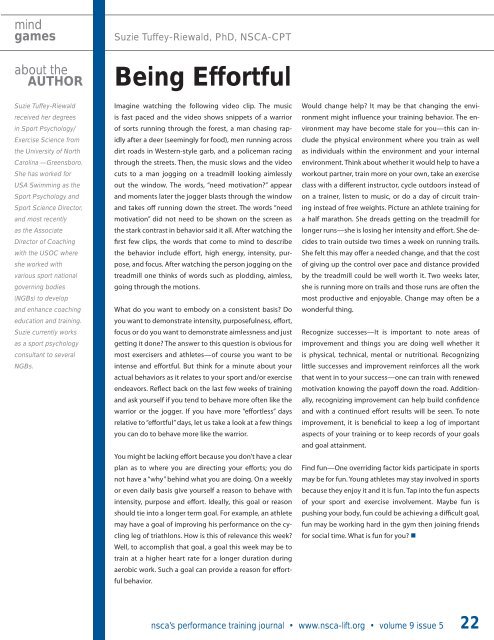PTJ Sep Oct 2010.pdf
PTJ Sep Oct 2010.pdf
PTJ Sep Oct 2010.pdf
Create successful ePaper yourself
Turn your PDF publications into a flip-book with our unique Google optimized e-Paper software.
mind<br />
games<br />
Suzie Tuffey-Riewald, PhD, NSCA-CPT<br />
about the<br />
AUTHOR<br />
Suzie Tuffey-Riewald<br />
received her degrees<br />
in Sport Psychology/<br />
Exercise Science from<br />
the University of North<br />
Carolina —Greensboro.<br />
She has worked for<br />
USA Swimming as the<br />
Sport Psychology and<br />
Sport Science Director,<br />
and most recently<br />
as the Associate<br />
Director of Coaching<br />
with the USOC where<br />
she worked with<br />
various sport national<br />
governing bodies<br />
(NGBs) to develop<br />
and enhance coaching<br />
education and training.<br />
Suzie currently works<br />
as a sport psychology<br />
consultant to several<br />
NGBs.<br />
Being Effortful<br />
Imagine watching the following video clip. The music<br />
is fast paced and the video shows snippets of a warrior<br />
of sorts running through the forest, a man chasing rapidly<br />
after a deer (seemingly for food), men running across<br />
dirt roads in Western-style garb, and a policeman racing<br />
through the streets. Then, the music slows and the video<br />
cuts to a man jogging on a treadmill looking aimlessly<br />
out the window. The words, “need motivation” appear<br />
and moments later the jogger blasts through the window<br />
and takes off running down the street. The words “need<br />
motivation” did not need to be shown on the screen as<br />
the stark contrast in behavior said it all. After watching the<br />
first few clips, the words that come to mind to describe<br />
the behavior include effort, high energy, intensity, purpose,<br />
and focus. After watching the person jogging on the<br />
treadmill one thinks of words such as plodding, aimless,<br />
going through the motions.<br />
What do you want to embody on a consistent basis Do<br />
you want to demonstrate intensity, purposefulness, effort,<br />
focus or do you want to demonstrate aimlessness and just<br />
getting it done The answer to this question is obvious for<br />
most exercisers and athletes—of course you want to be<br />
intense and effortful. But think for a minute about your<br />
actual behaviors as it relates to your sport and/or exercise<br />
endeavors. Reflect back on the last few weeks of training<br />
and ask yourself if you tend to behave more often like the<br />
warrior or the jogger. If you have more “effortless” days<br />
relative to “effortful” days, let us take a look at a few things<br />
you can do to behave more like the warrior.<br />
You might be lacking effort because you don’t have a clear<br />
plan as to where you are directing your efforts; you do<br />
not have a “why” behind what you are doing. On a weekly<br />
or even daily basis give yourself a reason to behave with<br />
intensity, purpose and effort. Ideally, this goal or reason<br />
should tie into a longer term goal. For example, an athlete<br />
may have a goal of improving his performance on the cycling<br />
leg of triathlons. How is this of relevance this week<br />
Well, to accomplish that goal, a goal this week may be to<br />
train at a higher heart rate for a longer duration during<br />
aerobic work. Such a goal can provide a reason for effortful<br />
behavior.<br />
Would change help It may be that changing the environment<br />
might influence your training behavior. The environment<br />
may have become stale for you—this can include<br />
the physical environment where you train as well<br />
as individuals within the environment and your internal<br />
environment. Think about whether it would help to have a<br />
workout partner, train more on your own, take an exercise<br />
class with a different instructor, cycle outdoors instead of<br />
on a trainer, listen to music, or do a day of circuit training<br />
instead of free weights. Picture an athlete training for<br />
a half marathon. She dreads getting on the treadmill for<br />
longer runs—she is losing her intensity and effort. She decides<br />
to train outside two times a week on running trails.<br />
She felt this may offer a needed change, and that the cost<br />
of giving up the control over pace and distance provided<br />
by the treadmill could be well worth it. Two weeks later,<br />
she is running more on trails and those runs are often the<br />
most productive and enjoyable. Change may often be a<br />
wonderful thing.<br />
Recognize successes—It is important to note areas of<br />
improvement and things you are doing well whether it<br />
is physical, technical, mental or nutritional. Recognizing<br />
little successes and improvement reinforces all the work<br />
that went in to your success—one can train with renewed<br />
motivation knowing the payoff down the road. Additionally,<br />
recognizing improvement can help build confidence<br />
and with a continued effort results will be seen. To note<br />
improvement, it is beneficial to keep a log of important<br />
aspects of your training or to keep records of your goals<br />
and goal attainment.<br />
Find fun—One overriding factor kids participate in sports<br />
may be for fun. Young athletes may stay involved in sports<br />
because they enjoy it and it is fun. Tap into the fun aspects<br />
of your sport and exercise involvement. Maybe fun is<br />
pushing your body, fun could be achieving a difficult goal,<br />
fun may be working hard in the gym then joining friends<br />
for social time. What is fun for you •<br />
nsca’s performance training journal • www.nsca-lift.org • volume 9 issue 5 22





